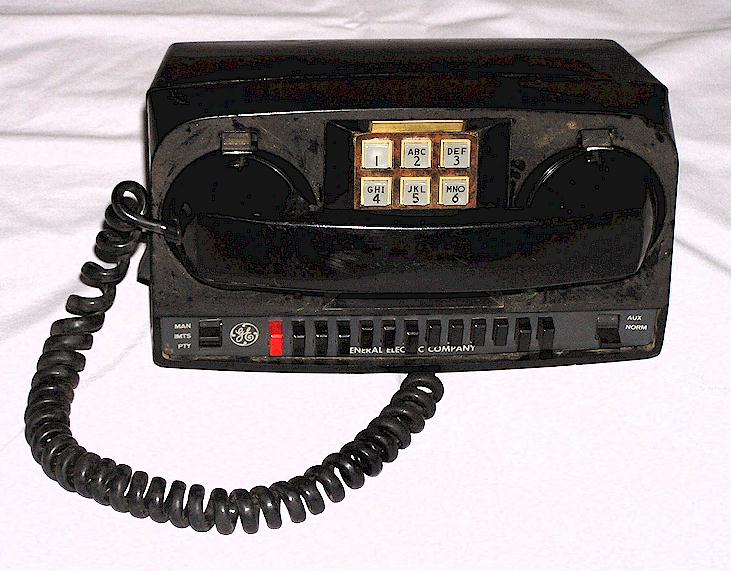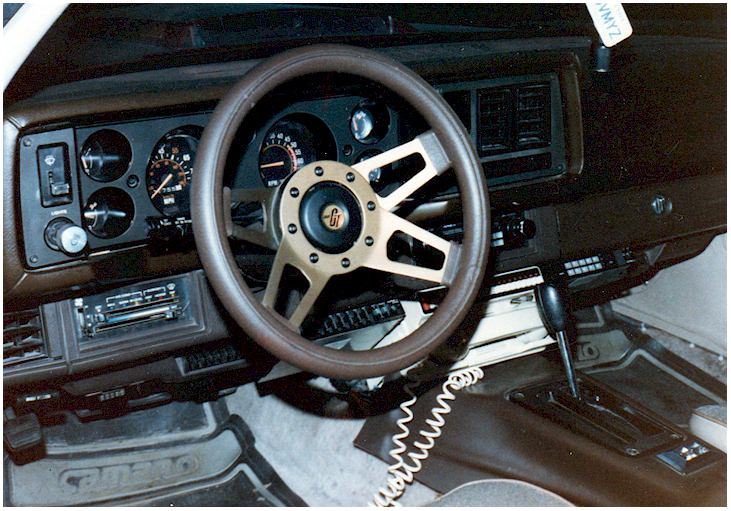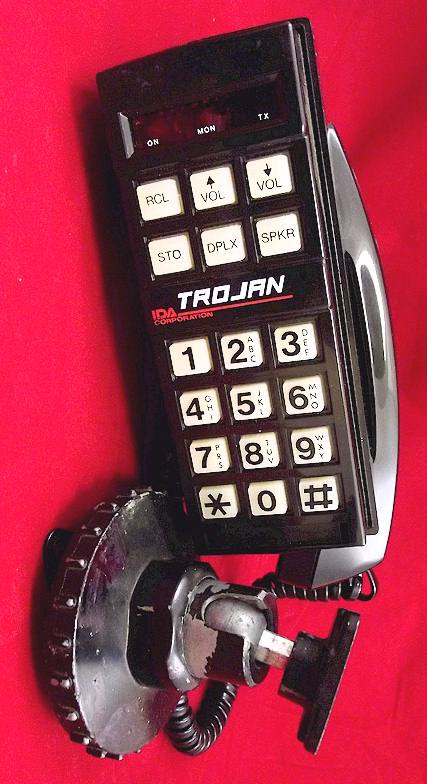CHAPTER 10
AFTERMARKET
IMTS CONTROL HEADS
A number of "modern" appearance control heads were sold in the late 1970's through the early 1990's to be retrofitted onto earlier mobile telephone systems. These newer heads offered self contained IMTS signaling and supervisory operation, were keyboard programmable, and offered memory number and roaming channel lists. The principal makers were Glenayre, Johnson and US Communications (later absorbed by E.F. Johnson). Secode and Harris RF also offered add-on control heads which could be made compatible with other maker's equipment. The manuals usually contained application sheets explaining how to configure them to function on assorted makers' RF packages.
SECODE
Beginning in the early 1960's, Secode manufactured a variety of mobile telephone control heads and signaling chassis, primarily for the RCC market but some of which were also used with MTS telephones. Secode later manufactured OEM control heads for GE and others, and had manufactured the decoder chassis for GE mobile telephones beginning in the late 1950's.
Most of the Secode heads contained VP- series model numbers and the earliest models, such as the VP-1, were dial-less types and looked the same as the traditional "MJ" IMTS control head except with a blank plate where the dial would have been. The signaling decoders were usually (always?) built-in.
It is unknown whether it ever made it to production, but Secode also attempted to market an interesting "cordless handset" accessory for an IMTS phone, which allowed the handset to be removed from the vehicle and taken some distance away. At least one aftermarket cell phone company (located in California) copied the same concept, using a conventional cordless telephone handset with a Johnson AMPS cellular phone radio drawer. These ideas never bore fruit, presumably because IMTS was already near its end by the time the concept was created, and hand-held self contained cellular telephones were already becoming available, in an even smaller size.
Secode was the most prolific manufacturer of tone signaling devices and control heads, and manufactured the VP-1 through VP-10 series control heads. The "IMTS" appears to have been the only self contained IMTS unit in the series. The VP-5 control head appears very similar to the IMTS but was made for RCC mobile telephone equipment. Secode merged with Repco at some point in the 1990's but is no longer in business (nor is Aerotron-Repco.)
The Secode "IMTS" model head is shown below and is one of their last products for a mobile telephone. It dates from 1976 and had four models - - One being a binary line channel select version and the other three being configurations of common negative or common positive channel selection. It was available in several colors. Most seem to have been sold as OEM equipment to GE, which labeled them with their own logo as shown below and assigned them such model numbers as 19C307188P 82 . Technically these could have been configured to be used with almost any mobile telephone chassis of the time, although the manual only points out cable wiring for the Motorola MJ and the GE Executive II series radios. Note that it looks almost exactly like a Motorola Pulsar control head, upside down!
Shown below is the version of the Secode IMTS head with a DTMF style pushbutton dial. Note that most IMTS terminals were not equipped to handle DTMF tones, so roaming was probably more limited with this model. The woodgrain contact paper, iconic of the 1970's, has dried up and fallen off the housing of this one, which was configured for use with a GE Executive II UHF mobile telephone package. The rather large rocker switch on the left side is to set the lighting brilliance at "full" or "half

GLENAYRE
Glenayre, a Canadian based company, began producing aftermarket digital control heads for existing equipment in the early 1970's, starting with the GL-1400 head (see Chapter 7) which was MTS only with outscan. The GL-1400 looked almost identical to the GL-2000. Outscan was the capability of finding a free channel in the MTS mode. The 1400 was followed by the GL-2000, and later the GL-2020, followed by the GL-2021. The 2021 has extra features but otherwise appears identical to the 2020. In the 1980's, Glenayre would offer a combination cellular/IMTS telephone which consisted of their GL-3000 control head, mated to Spilsbury VHF equipment and Glenayre manufactured cellular equipment.. The Glenayre aftermarket heads were extremely popular in the 1980's, usually replacing rotary dial heads on older Motorola and GE "MJ" IMTS equipment and for converting older duplex MTS-only equipment to full featured IMTS. Glenayre heads were available in black and an off-white. Glenayre ceased marketing IMTS equipment in the 1990's although they still marketed Autotel equipment in Canada (Autotel is a proprietary 1980's Canadian format that was actually closer to AMPS than IMTS and used only in Canada, but see below.)
The GL-2000 is shown below. Undoubtedly one of the uglier IMTS control heads, although beauty is in the eye of the beholder. It has a grille where one would expect a speaker or a dial, yet with nothing behind it, and the small momentary pushbuttons for the channels also act as the number pad when dialing. There are round LED indicators above each channel button, which indicate the channel the radio is operating on (as well as showing scan activity) and there is a small numeric LED display below the Glenayre logo which indicates the number being dialed. The GL-2000 could be supplied with a cable to match almost any radio package on the market. The head is programmed by holding down several specific buttons while powering it up, and entering the channel list and phone number. The memory board uses three small aspirin-shaped nicad back-up batteries which leak acid vapors onto the adjacent circuitry and cause moderate to extensive corrosion. There are various versions of firmware in the GL-2000, which mainly controls how the scan display will be handled. There are also various versions of the interface board configurations in the GL-2000, which determine which radio telephone drawer the head will be used with.
Shown below is a white GL2000
installed in a Z-28 Camaro in 1984, courtesy Lance from Las Vegas:
Below is a Russian VHF mobile telephone, the Altai AS-3, from approximately 1980, designed by an American contractor and used in the Soviet government radiotelephone network. Few private citizens in Russia owned cars, much less a mobile telephone. Pay no attention to Russian website babble claiming they invented or designed this, or the mobile telephone itself. Notice the similarity to the Glenayre GL-2000 above, designed at the same time. They look quite similar.
CLICK HERE TO SEE MORE RUSSIAN MOBILE PHONES
Below is an example of the GL-2020 / 2021 head. These heads were extremely popular and similar to cellular heads. As with the 2000 series, they were made available with many interface cables to function with practically anyone's radio package. Programming is accomplished by depressing a certain series of keys in a certain order and then following a programming matrix described in the service manual. The 2020 and 2021 series contain a speaker for on-hook dialing but do not feature a speaker-phone option. All the Glenayre heads had the ability to store two separate subscriber telephone ID numbers (ANI's) and could give billing interval beeps to the user so that he could determine what the call was costing (remember...these were the days of $ 1.00 per minute IMTS phone calls!) It was also possible to create home and roam channel lists, and specify which ANI number was to be used on which channel, which channels were MTS and which were IMTS, and so forth. The 2021 head was somewhat more expensive than the 2020 and for some reason one often finds 2020 circuitry hidden inside 2021 series plastic shells. One can only wonder whether this was some sort of dealer chicanery?
AUTOTEL
Although it is not IMTS and outside the scope of this web page, I received a nice letter about Canadian Autotel history from Peter Trill and part of it is shared on this page-----> AUTOTEL .
HARRIS RF (See also Chapter 9)
Harris Corporation's first offering for Bell System applications was a self-contained IMTS control head with rotary dial, the RF-4900 series, which could be used with their own RF-150 mobile radio package or with any other equipment such as the Motorola TLD-1000 or TLD-1100. Dates from the early 1970's, more or less. In the case of equipment such as the Motorola, which contained internal tone signaling and supervisory circuits, it was necessary to remove or bypass those circuits first. Available in beige, white or black. This was superseded in the 1980's by the Alpha 40 control package, which also could be added to most any older radio made by other manufacturers (see description and photos in the previous chapter.) RF-4911 "revertive call" model is shown below (VHF labeled.) The "P" button refers to the revertive call feature, which allowed two mobiles to converse on the same channel by dropping each one's carrier when the "P" button was pressed, the mobiles then continuing in a "push to talk" fashion. I was told that this head was disliked by dealers as it had a number of issues with reliability as well as a confusing method of operation. Note the blank button on the far right where the twelfth channel would be on a UHF or Canadian version. There is an Elco connector on the rear, as usually found on Secode branded control heads. This head contains all the supervisory signaling and logic circuitry. The number ID is set by a series of jumper wires. It is about the same size as the Glenayre GL-2000 head and looks surprisingly similar..
U.S. COMMUNICATIONS (Callmaster)
The Callmaster MT-270 (RCC) and MT-200 / MT-300 (IMTS) were fully IMTS self contained aftermarket control heads made by U.S. Communications in Idaho, inside what was essentially a GTE / Automatic Electric Touch-Tone® "Starlite" princess-style housing. In the early 1980's, U.S. Communications was absorbed by E.F. Johnson, and the Idaho facility was closed. The Callmaster generated a rather high amount of heat from its primitive internal logic and required a rather thick base plate to act as a heat sink, as did the bracket and the car floor. It also required a special very lengthy keypad sequence to program it, which can best be described as very primitive if not ridiculous. The Callmaster heads were available in at least beige or black. The MT-200 heads were used by Pacific Telephone in 1982, connected to either a GE Executive II RF duplex package or a Motorola Pulsar 100 radio. They were also sold by Western Mobile Telephone in Anaheim, California throughout the 1980's to early 1990's either by themselves or attached to such radios as refurbished 1960's GE MASTR CC56 RF packages or MASTR Executive II units.. U.S. Communications has no relation to United States Communications of Los Angeles, an early importer of PYE British RF packages which were made into MTS telephones with the addition of a solid state decoder and a modified Automatic Electric "Starlite" telephone (see ARC/PYE "Cambridge" above.) Note that the AE "Starlite" plastic housings were subject to severe "yellowing" and even "browning" caused by a photochemical reaction in the flame-retardant additive applied in the plastic molding process. The example below is a case in point. An additional major aggravation concerning these heads is that the manufacturer thoughtlessly created special firmware masks in ROM regarding the programming, on a per-customer basis, such that there is no single, universal password which initiates the programming. For example, the Pacific Telephone MT200W heads use a different password phrase than regular MT200's, and the MT270 RCC model uses yet another password. If you need the passwords and programming strings, contact me and I will share what I have. At least in the 1980's, E. F. Johnson's service department still released copies of the special customer programming codes, with some prodding.
E.F. Johnson
Johnson manufactured an aftermarket control head which resembled the Glenayre 2020 series, and which was probably intended to be sold with the Johnson MT-580 Series RF packages of the 1980's although it was sold separately. It is believed that the Johnson head was the final design from the old U.S. Communications company of Idaho, which was absorbed by E. F. Johnson in the early 1980's. There was apparently a final U.S. Communications head design which was similar to or identical to this one other than the manufacturer logo. This Johnson IMTS head looks similar to the one and only "Western Union" cellular AMPS head of the same era. The Johnson head has a built-in speaker for on-hook dialing but does not feature hands-free operation.
IDA TROJAN
This seems to be a rare control head which in appearance looks similar to the Glenayre 2020 series but has different key-button assignments. It is not known if this was IMTS but it is included here in the interest of completeness. The nametag on it says:
IDA Corporation, Fargo, ND
Model Trojan III M11
Options 242, 246
Any information on this item would be appreciated.
-UPDATE 12/2017: Fellow collector Tony Campanale advises me that this head is not IMTS, it merely contains a DTMF encoder.

Ver. 08/11/2020 © 2005 All rights reserved